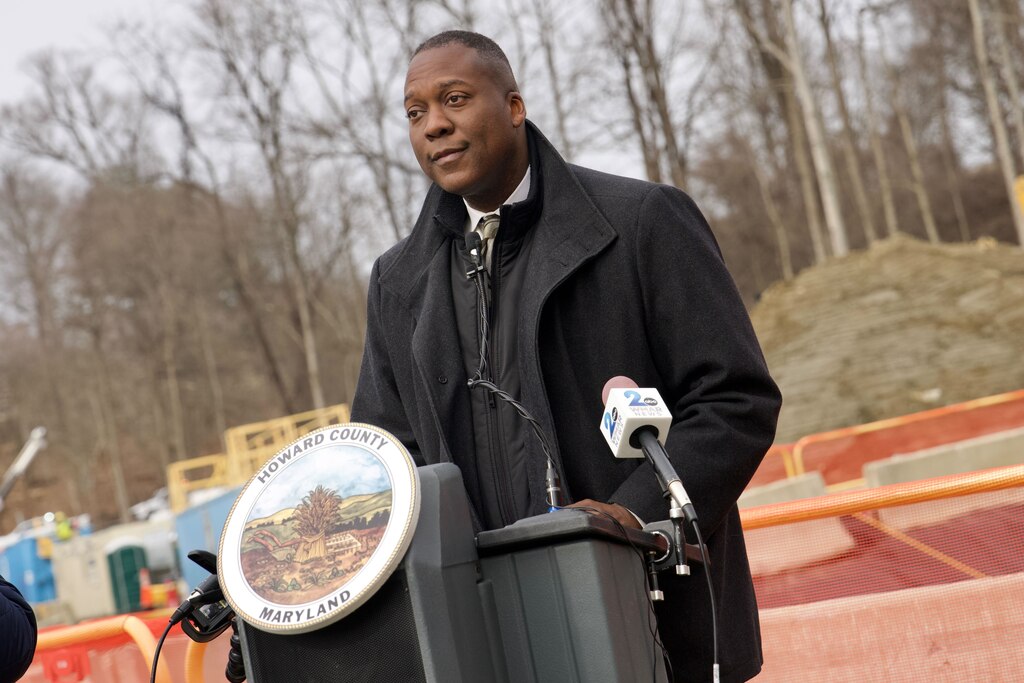Neither solid granite nor federal funding uncertainty has stalled Howard County leaders’ plans to bore a mile-long tunnel under Old Ellicott City to the Patapsco River this fall.
From the edge of a manmade crater along Frederick Road where the tunnel is planned, Howard County Executive Calvin Ball said Monday that the jurisdiction’s single largest public works project will move forward as planned in part thanks to $38.1 million in new financing from the state of Maryland.
A week ago, Ball seemed less certain. He named the Extended North Tunnel project, a major focal point of his administration’s plan to reduce the risk of deadly flash flooding along historic Ellicott City’s Main Street, as one of several critical infrastructure projects that could be affected by federal funding freezes or cuts under President Donald Trump.
Just days after Trump’s inauguration, the president ordered — and then rescinded — a federal spending hiatus that incited confusion within local governments like Howard County’s.
The Baltimore Banner thanks its sponsors. Become one.
“We are hopeful that our partners at the federal level will continue along the promises and commitments that they’ve already made to move this project forward,” Ball said.

The flood mitigation plan is hugely consequential for Ellicott City, which lies in a steep-sloped valley and suffered catastrophic flash floods in 2011, 2016 and 2018. It’s also a major priority for the county executive, who launched the plan in early 2019 during his first 30 days in office.
Ball has called the plan “aggressive” and believes it will make Ellicott City a model for climate resilience.
The mile-long tunnel will have an 18-foot diameter capable of funneling floodwaters away from Main Street to the Patapsco. The tunnel will have the capacity to channel 26,000 gallons of water per second, county officials said in a news release.
Other projects included in the Ellicott City Safe and Sound plan include five stormwater retention ponds, two stormwater conveyance projects, debris management, a flash flood alert system and signage directing the public toward high ground.
The Baltimore Banner thanks its sponsors. Become one.
Funding comes from a mix of local, state and federal sources. The tunnel project alone is expected to cost the county $141 million, including about $75 million from a federal low-interest loan awarded by the Environmental Protection Agency under the Water Infrastructure Finance and Innovation Act. It’s unclear whether that might change under Trump’s administration.
Meanwhile, Ball said, the new state funding will come in an $18.1 million low-interest loan from the Water Quality State Revolving Loan Fund and a $20 million low-interest loan from the Resilient Maryland Revolving Loan Fund. The latter will contribute $5 million each to the tunnel project, culverts on Maryland Avenue and two stormwater retention ponds.
The county has already completed construction of two retention ponds at the interchange of Routes 29 and 40 and near Rogers Avenue and Patapsco River Road. Together, they have the capacity to hold 7.5 million gallons during a storm.
A third retention pond along Frederick Road just west of Route 29 is expected to become operational in the fall, increasing stormwater retention capacity by 5.5 million gallons to a total of 13 million gallons. That’s the equivalent of a football field filled 30 feet deep with water, Ball said.
County crews broke ground on the tunnel project in June 2024. Later this fall, a tunnel boring machine, which Howard County residents voted to name “Rocky,” is scheduled to arrive from Ohio. The machine will help crews excavate the tunnel about 150 feet underground through rock to reach the Patapsco River.
The county expects to cut the ribbon on the tunnel in fall 2027.


Comments
Welcome to The Banner's subscriber-only commenting community. Please review our community guidelines.